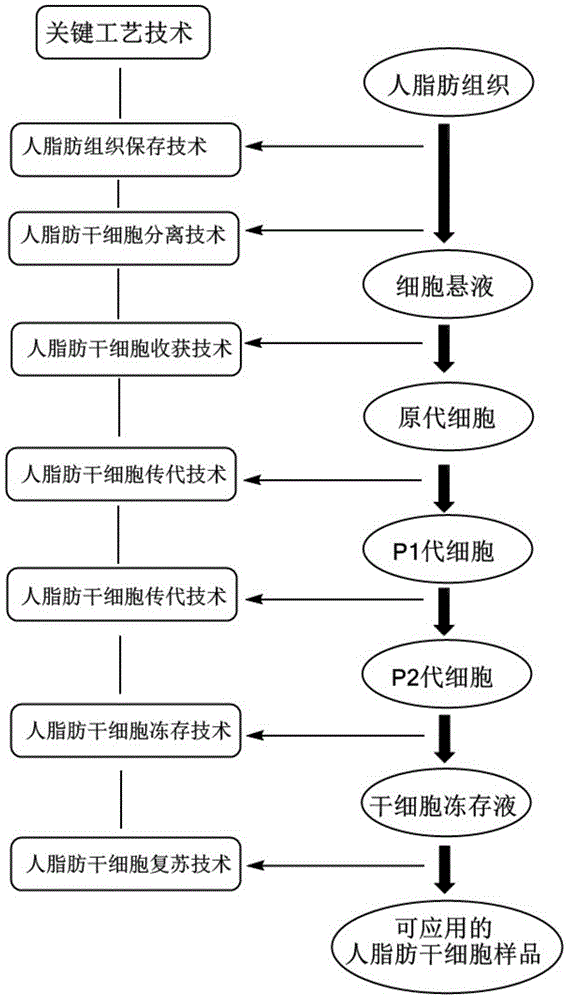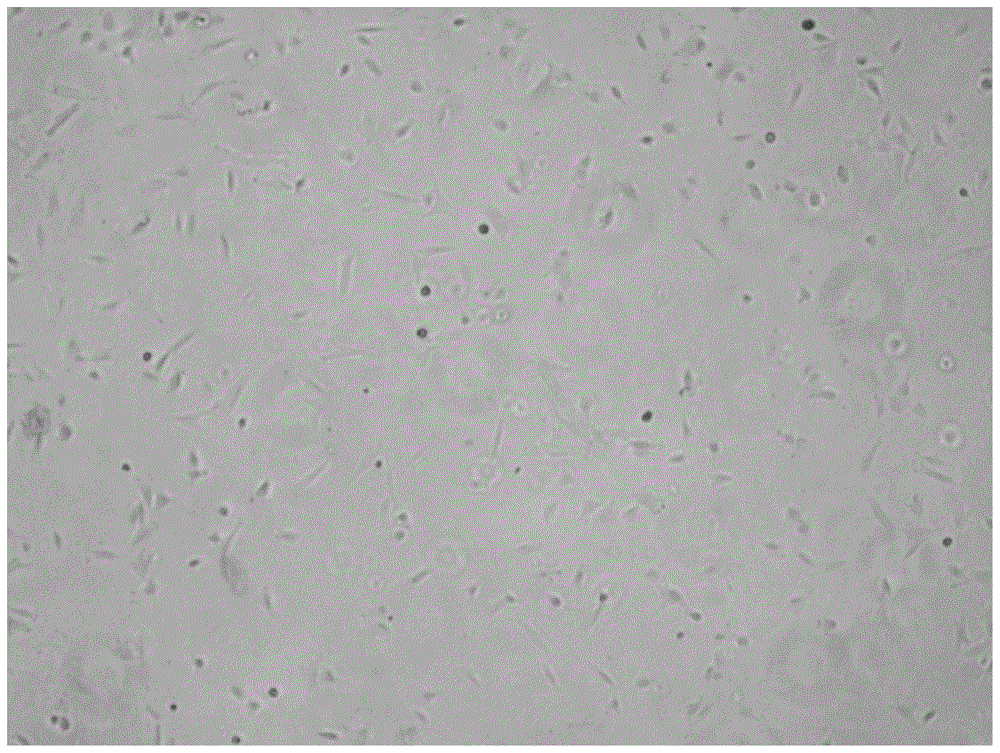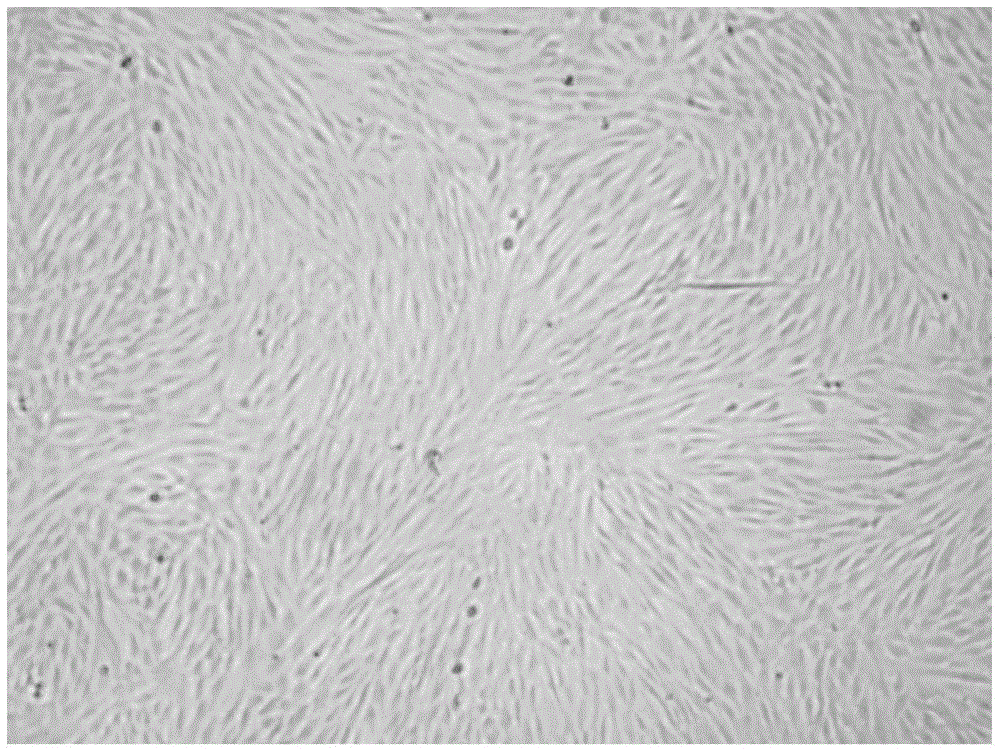A method for isolating human adipose stem cells from human adipose tissue
A human adipose stem cell and adipose stem cell technology, which is applied in the field of cell engineering, can solve the problems of unclean separation, low purity, and low purity and activity of human adipose stem cell products, so as to achieve a reduction in the content of foreign cells, good activity and favorable differentiation induction. Effect
- Summary
- Abstract
- Description
- Claims
- Application Information
AI Technical Summary
Problems solved by technology
Method used
Image
Examples
Embodiment 1
[0034] This embodiment provides a method for isolating human adipose stem cells from human adipose tissue, and culturing the isolated human adipose stem cells. details as follows:
[0035] (1) Isolation of human adipose stem cells from human adipose tissue
[0036] Washing: 15 mL of human adipose tissue was taken, and the human adipose tissue was repeatedly washed three times with normal saline to remove blood in the human adipose tissue.
[0037] Collagenase digestion: put the washed human adipose tissue into a 50mL centrifuge tube, then add an equal volume of type Ⅰ collagenase solution to the centrifuge tube, and mix well. Put it in a constant temperature shaker, and digest at a centrifugation rate of 150r / min for 1h at 37°C. The liquid in the centrifuge tube is divided into three layers, the upper layer is the yellow oily fat cell layer, the middle layer is the fat tissue layer, and the lower layer is the liquid containing mononuclear cells.
[0038] Collection: suck ou...
Embodiment 2
[0053] This embodiment provides a method for isolating human adipose stem cells from human adipose tissue, and culturing the isolated human adipose stem cells. The specific operation is basically the same as that in Example 1, except that the centrifugation rate (150r / min) during collagenase digestion in step (1) is changed to 100r / min. Other operations and parameters are completely consistent with those of Example 1.
[0054] During the above culture process, the human adipose stem cells of P0, P1, and P2 generations were continuously observed.
[0055] After P0 generation human adipose stem cells were cultured for 48 hours, observed under an inverted microscope, no cells adhered to the wall, and after 72 hours, a very small amount of cells adhered to the wall, and a large number of miscellaneous cells were suspended in the serum-free medium. After a series of medium replacement, digestion and passage, the number of miscellaneous cells suspended in the serum-free medium of P...
Embodiment 3
[0057] This embodiment provides a method for isolating human adipose stem cells from human adipose tissue, and culturing the isolated human adipose stem cells. The specific operation is basically the same as that in Example 1, except that the centrifugation time (1 h) during collagenase digestion in step (1) is changed to 0.5 h. Other operations and parameters are completely consistent with those of Example 1.
[0058] During the above culture process, the human adipose stem cells of P0, P1, and P2 generations were continuously observed.
[0059] After P0 generation human adipose stem cells were cultured for 48 hours, observed under an inverted microscope, no cells adhered to the wall, and after 96 hours, a very small amount of cells adhered to the wall, and a large number of miscellaneous cells were suspended in the serum-free medium. After a series of medium replacement, digestion and passage, the number of miscellaneous cells suspended in the serum-free medium of P1 genera...
PUM
 Login to View More
Login to View More Abstract
Description
Claims
Application Information
 Login to View More
Login to View More - R&D
- Intellectual Property
- Life Sciences
- Materials
- Tech Scout
- Unparalleled Data Quality
- Higher Quality Content
- 60% Fewer Hallucinations
Browse by: Latest US Patents, China's latest patents, Technical Efficacy Thesaurus, Application Domain, Technology Topic, Popular Technical Reports.
© 2025 PatSnap. All rights reserved.Legal|Privacy policy|Modern Slavery Act Transparency Statement|Sitemap|About US| Contact US: help@patsnap.com



